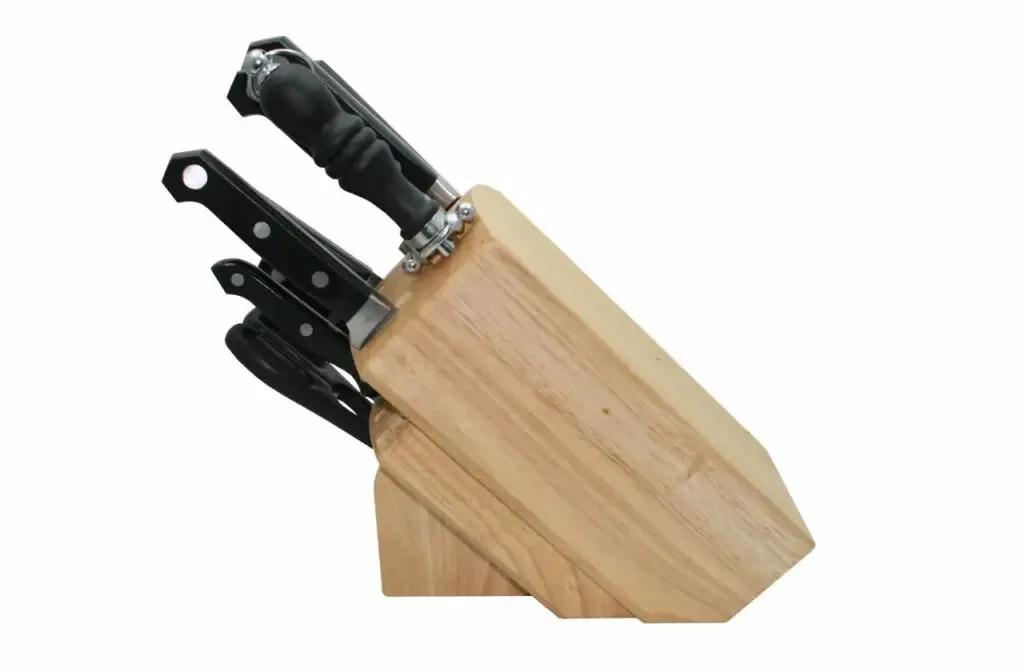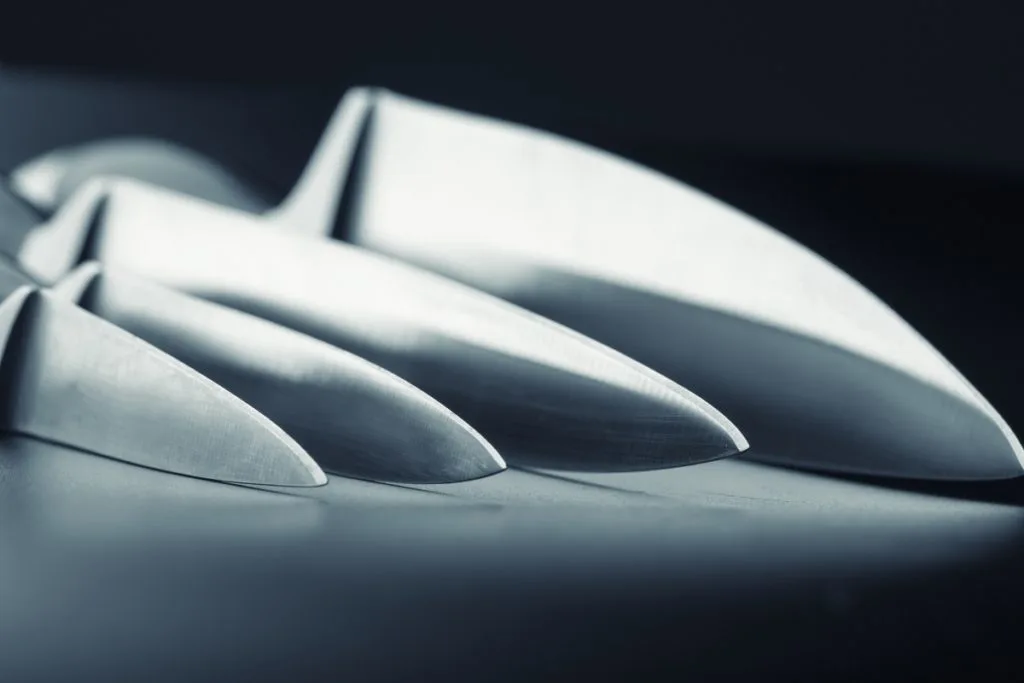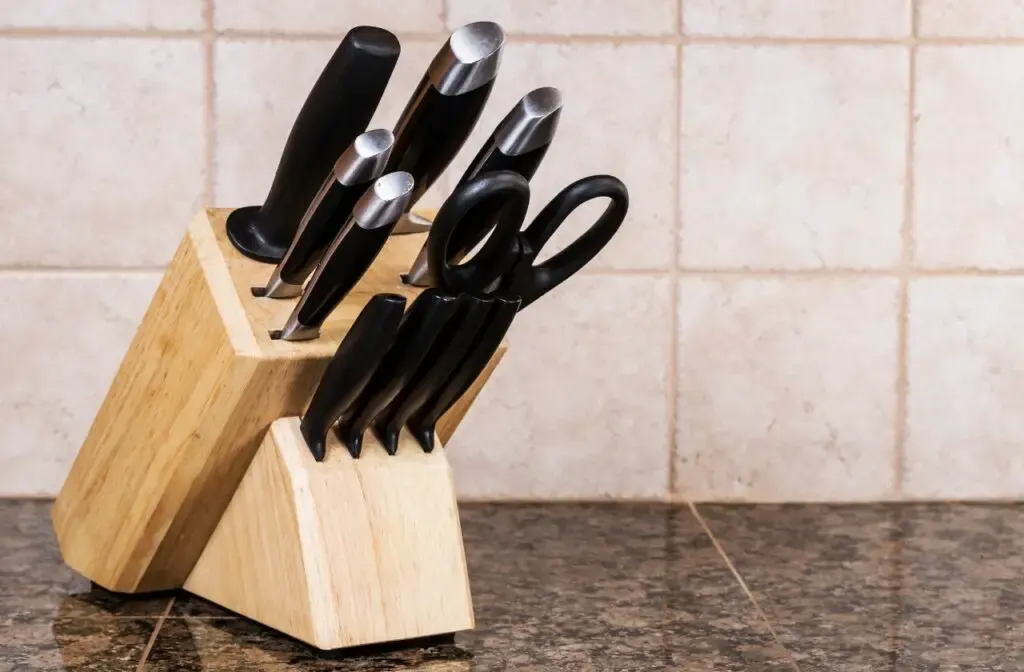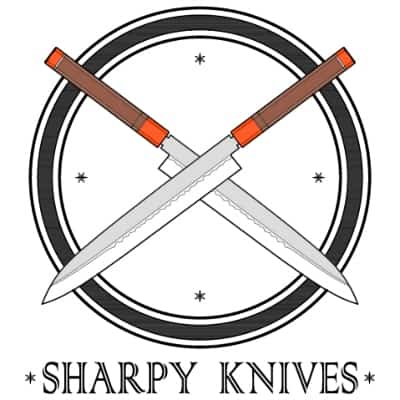As an Amazon Associate, we earn from qualifying purchases with no additional costs for you.
The concept of a self-sharpening knife sounds a little mysterious and magical, as if it is something that belongs in fiction rather than real life! How do self-sharpening knives work, and are they worthwhile, or is it a sales gimmick?
Self-sharpening knives have a sharpening mechanism built into the knife block or sheath that hones the edge every time the knife blade is withdrawn or inserted in the storage block or sheath. This continual honing keeps the knife sharp for longer, requiring less frequent sharpening.
Self-sharpening knives may sound futuristic and a little hard to believe, but they do exist, particularly in the kitchen knife sector. The self-sharpening name may be a little more flashy sounding than how these knives work in reality, but we can show you exactly how these knives work and whether they are worth the investment!
If you are interested in checking out the best self-sharpening knife set, you can find it by clicking here (Amazon link).

What Is A Self-Sharpening Knife?
When most people hear about self-sharpening knives for the first time, they immediately think that the knife is made from a new type of steel that does not get dull.
Unfortunately, no steel can be used to produce a knife that never dulls, and any manufacturer claiming that their knives never go dull should not be trusted.
Knives that never go dull are not the same claim as self-sharpening knives, but the name can be a little misleading since the self-sharpening has nothing to do with the knives themselves.
Self-sharpening knives are not made from any special material or fancy new technology. The knives are normal, regular steel knives. So, how does the self-sharpening aspect come into play with these knives if they are no different from any other kitchen knives?
What Does Self-Sharpening Mean?
Most people understand the concept of self-sharpening to mean that the knives stay sharp with no physical intervention necessary by the knife owner.
As people, we are always looking for better, more efficient ways to get mundane tasks done in less time and with as little inconvenience as possible.
This penchant of humankind has led to the development of self-sharpening knives that require less maintenance than standard knives.
Since traditional knife sharpening is a skill that takes time to learn, many people do not have the time, scope, or patience to put the effort into learning how to sharpen knives properly.
Knife manufacturers saw this as an opportunity to present knives to the public that do not require sharpening as frequently as other knives and no special skill is required to keep these knives sharp.
We have already seen how there is nothing special about the knives or the steel they are made from, so the secret of the self-sharpening process lies elsewhere. The self-sharpening mechanism is related to the storage housing for the knives rather than any special property of the knives themselves.
All self-sharpening knives will come with a knife block for safe, convenient storage of the knife, and it is the storage block that holds the secret to the self-sharpening magic.
Every time the knife is withdrawn or replaced in its position in the knife block, the knife’s edge is honed by the mechanism hidden inside the slot in the storage block.
BTW: If you want to know more about Japanese and other knives and their sharpening, check out the books listed above. These books are recommended by professional sharpeners and knife makers (Amazon links):
- Japanese Kitchen Knives: Essential Techniques and Recipes
- The Knifenerd Guide to Japanese Knives
- Knife: The Culture, Craft, and Cult of the Cook’s Knife
- Sharp: The Definitive Introduction to Knives, Sharpening, and Cutting Techniques, with Recipes from Great Chefs
How Does a Self-Sharpening Knife Work?

The self-sharpening characteristics of a self-sharpening knife have to do with how the knife is stored rather than any special characteristic of the knife itself.
The marketing should refer to the self-sharpening knife block rather than self-sharpening knives since it is the knife block that hones the knife’s cutting edge.
Essentially, each slot in the knife block is modified to house a sharpening device for each individual knife slot. This converts the knife block into a pull-through sharpener for each knife slot.
The sharpening mechanism in the knife block varies from manufacturer to manufacturer and is designed for the knives it is intended to store. As a result, most self-sharpening knives come as a set, paired with the manufacturer’s knife block, which does the actual sharpening.
Some blocks have a carbide sharpening stone in a “V” formation embedded near the opening of the slot in the knife block. Other manufacturers prefer a ceramic sharpening “V” to straighten and polish the knife edge.
Other self-sharpening knife blocks have the abrasive in the form of wheels rather than the sharpening “V” already mentioned. Irrespective of the abrasive material used, the principle of how the self-sharpening works is the same.
As the knife is withdrawn from the slot, the position of the abrasive ensures that the length of the knife’s cutting edge is dragged across the sharpener. This action of drawing the knife from the slot automatically hones the edge of the knife, ensuring it is sharp and ready for use immediately once it is withdrawn.
Likewise, when the knife is returned to the storage block after use, the action of inserting it into the slot once again causes the edge to come into contact with the sharpening mechanism. The edge is honed as the knife slides into its storage slot to restore sharpness after use.
TIP: Most people own multiple types of knives, each with different sharpening requirements. Find out answers on how often to sharpen different knives in the article below:
How Often To Sharpen A Knife? (Answers For All Knife Types)
Can You Buy A Single Self-Sharpening Knife
It is not always necessary to purchase an entire set of self-sharpening knives since some manufacturers sell the knives individually.
In this case, the knife comes with a sheath for the blade, which has the sharpening mechanism incorporated into the structure of the single knife sheath. This provides the same sharpening function on the knife each time the knife is withdrawn and returned to the sheath for storage.
How To Use A Self-Sharpening Knife Set

With the knowledge that the sharpening mechanism for the knife is in the slot of the block, you need to be aware of your extraction and insertion technique for the knife.
Correctly withdrawing and inserting the knife allows the sharpening mechanism to properly hone the edge and give you maximum benefit from the embedded sharpener.
The correct method to use with a self-sharpening knife set is as follows.
- Extract the knife in one smooth motion. Ensure the knife is pulled out in one smooth action rather than a stop-start motion to ensure even contact with the sharpening mechanism.
- Do not extract the knife too fast. Pulling the knife out faster does not increase the mechanism’s sharpening on the knife edge. A normal extraction speed is sufficient to hone the edge.
- Don’t angle the knife edge up as it is extracted. Keep the knife’s handle in the same plane as you pull the knife out. Do not angle the knife up as it is extracted; this action will not allow the entire length of the cutting edge to contact the sharpener.
- Do not exert additional pressure on the knife when withdrawing it. It is not necessary to apply any additional pressure to force the cutting edge to make firm contact with the sharpener. The sharpener is designed to work without any additional pressure.
- When replacing the knife, do not force it into the slot. Allow the knife to slide into the slot in the storage block under its own weight. There is no need to push the knife into the block. The weight of the knife is sufficient to ensure the cutting edge makes contact with the sharpening mechanism.
TIP: Keeping a knife sharp should be a major priority for any knife you have and use regularly. Find out the explanation of why it is important to sharpen your knives before use in the article below:
4 Reasons Why It Is Important To Sharpen A Knife Before Use
Do Self-Sharpening Knives Really Work?

The big question many skeptic knife owners ask is whether self-sharpening knives really work or if it is a marketing ploy intended to sell more knives to unsuspecting buyers.
As with most products available on the market, there are good, well-made products that work well and others that try to imitate the good products but don’t work so well. The same principle applies to self-sharpening knives.
A good set of self-sharpening knives works well, and the sharpening mechanism serves to keep the cutting edge in good shape, extending the time in between required sharpening.
Do Self-Sharpening Knives Need Sharpening?
Self-sharpening knives stay sharp for longer because of the frequent touching up of the knife edge every time the knife is withdrawn and replaced in the storage block. Does this mean that these knives never require sharpening?
Unfortunately, this idea is another consequence of a misunderstanding due to the naming of the self-sharpening knives. The process the knives undergo when they are removed and inserted in the storage block is not really sharpening but rather honing.
This process is more akin to honing the knife on honing steel rather than sharpening the knife on a set of whetstones, which is a substantially different process.
The purpose of honing steel is not to remove material from the knife’s cutting edge but rather to straighten a rolled-over edge or an edge that is out of alignment with the knife.
This process has the same intention as the self-sharpening function in the storage block. The cutting edge is re-aligned and polished to restore sharpness. Some self-sharpening systems with carbide or diamond abrasives will remove small amounts of material from the cutting edge, but ceramic abrasives will remove less material from the knife.
Consequently, our preference for self-sharpening systems uses ceramic sharpeners, which do a better job at straightening and polishing the edge without removing much material from the knife.
Self-sharpening knives will still need to be sharpened periodically in the same way the standard knives will need sharpening. However, the continuous honing of the edge of these knives reduces the frequency with which they need sharpening.
TIP: Not all knives can hold a sharp edge and stay sharp for a long time. Check out the best edge-holding knives in the article below:
These 3 Kitchen Knives Hold the Best Edge (You Should Try)
What Are the Best Self-Sharpening Knives (Set)

As we have already mentioned, there are good and bad products in every market sector, which makes it challenging to know whether you are buying a worthwhile product or not.
To this end, we have selected two self-sharpening knife sets that we can recommend from renowned manufacturers. If you are new to self-sharpening knives, you can rest assured that these knife sets will not disappoint from a quality and manufacture point of view!
We highly recommend these self-sharpening knife sets, one produced in France and the other produced by the well-known German knifemaking company Henckels.
HENCKELS Definition Self-Sharpening Knife Block Set
Henckels is a knife-making company that traces its knifemaking roots back to the early 1700s. The company specializes in making quality kitchen knives and has become one of the leading chef’s knife producers worldwide.
The HENCKELS Definition Self-Sharpening Knife Block Set (Amazon link) comes with the heritage of this German knifemaking family, guaranteeing quality knives throughout the set.
The set includes the following items.
- Paring Knife – 3-inch
- Serrated Utility Knife – 5-inch
- Utility Knife – 6-inch
- Santoku Knife – 7-inch
- Bread Knife – 8-inch
- Chef’s Knife – 8-inch
- Six Steak Knives – 4.5-inch each
- Kitchen Shears
- Self-Sharpening Knife Block
The knives are all stamped stainless steel, making cleaning and maintenance of the knives a simple task. The slots for the steak knives are not self-sharpening since these serrated blades require less maintenance to remain sharp.
The sharpening mechanism in the block is built-in honing wheels made from ceramic materials to keep the knives sharp while reducing the amount of material removed from the cutting edge.
If you are interested in buying the HENCKELS Self-Sharpening Knife Set, check out the latest prices on Amazon.
Sabatier Self-Sharpening Edgekeeper Pro Set
This is another high-quality self-sharpening knife set that carries our recommendation as a quality, reliable product.
The Sabatier Self-Sharpening Edgekeeper Pro Knife Set (Amazon link) is a 12-piece set, including the self-sharpening knife block. The knives are all made from forged high-carbon stainless steel, which gives carbon-steel-like edge retention with all the benefits of stainless steel.
The set includes the following items.
- Chef’s knife – 8-inch
- Slicer knife – 8-inch,
- Chefs knife with Kullens or Granton edge – 5-inch
- Fine edge utility knife – 4.5-inch
- Paring knife – 3.5-inch
- Six steak knives – 4.5-inch each
- Edgekeeper Self-sharpening block
The self-sharpening mechanism in this set is ceramic rods positioned in the “V” shape of pull-through sharpeners, with a set angle perfect for each knife.
If you are interested in buying the Sabatier Self-Sharpening Knife Set check out the latest prices on Amazon.
Is It Worthwhile Using Self-Sharpening Knives?
When it comes to kitchen essentials, knives hold a place of honor. Whether you’re a culinary expert or a home cook, the sharpness of your knife is pivotal to the cooking process.
This brings us to the innovative concept of self-sharpening knives, but are they truly a kitchen revolution or just a clever marketing strategy?
Self-sharpening knives, contrary to what the name suggests, do not possess any magical, ever-sharp qualities. They are regular knives that come with a built-in mechanism in their storage block or sheath that hones the blade each time you insert or withdraw the knife.
This feature is designed to maintain the knife’s edge, keeping it sharper for longer periods and reducing the frequency of manual sharpening.
For those who find the art of knife sharpening daunting or time-consuming, self-sharpening knives offer a convenient alternative.
They eliminate the need for regular maintenance and ensure that your knife is ready to use at a moment’s notice. This can be particularly appealing for busy individuals who value efficiency in the kitchen.
However, it’s important to note that self-sharpening knives are not a complete substitute for traditional sharpening methods. Over time, even these knives will require a proper sharpening session to restore their optimal edge.
The quality of the knife and the sharpening mechanism play a crucial role in the longevity and effectiveness of the self-sharpening feature.
If you’re considering self-sharpening knives, it’s advisable to invest in a high-quality set from a reputable manufacturer. Cheaper alternatives may not hold their edge as well and could end up costing more in the long run due to frequent replacements.
A well-made knife set, complemented by a reliable self-sharpening block, can be a worthwhile addition to your kitchen arsenal.
So, should the typical person bother buying self-sharpening knives? If convenience and time-saving are at the top of your list, then yes, these knives can be a valuable purchase.
However, for those passionate about cooking and knife care, investing in a premium knife set and learning the skill of knife sharpening could be more rewarding.
Not only does this ensure that you have control over the sharpness of your blades, but it also allows you to appreciate the craftsmanship that goes into a high-quality knife.
Before making a decision, weigh the pros and cons based on your cooking habits, time constraints, and willingness to engage in knife maintenance. Remember, the right tools in the kitchen can elevate your cooking experience, and sometimes, the old adage “sharpen your own knives” holds a slice of truth.
Self-sharpening knives are not just a gimmick; they serve a functional purpose. Yet, they are not an all-encompassing solution. For those who view cooking as an art, the ritual of manually sharpening your knife can be a meditative and satisfying experience that enhances your culinary journey.
Conclusion
Self-sharpening knives work by honing the knife edge each time the knife is withdrawn or replaced in the storage block or self-sharpening sheath. This keeps the knives sharper for longer, maintaining the cutting edge to prevent the need for frequent sharpening.
This process works well to keep the edge well-maintained, but if your knives are hardworking knives, they will need to be properly sharpened at some point to restore sharpness. The good news is that the self-sharpening mechanism will extend the time between these sharpening sessions!
TIP: Keeping your knives sharper for longer is not only convenient but can also help to extend the life of your knives. Check out the simple and proven tips in the article below:
5 Simple & Proven Tips: Keeping Your Knives Sharp Longer
